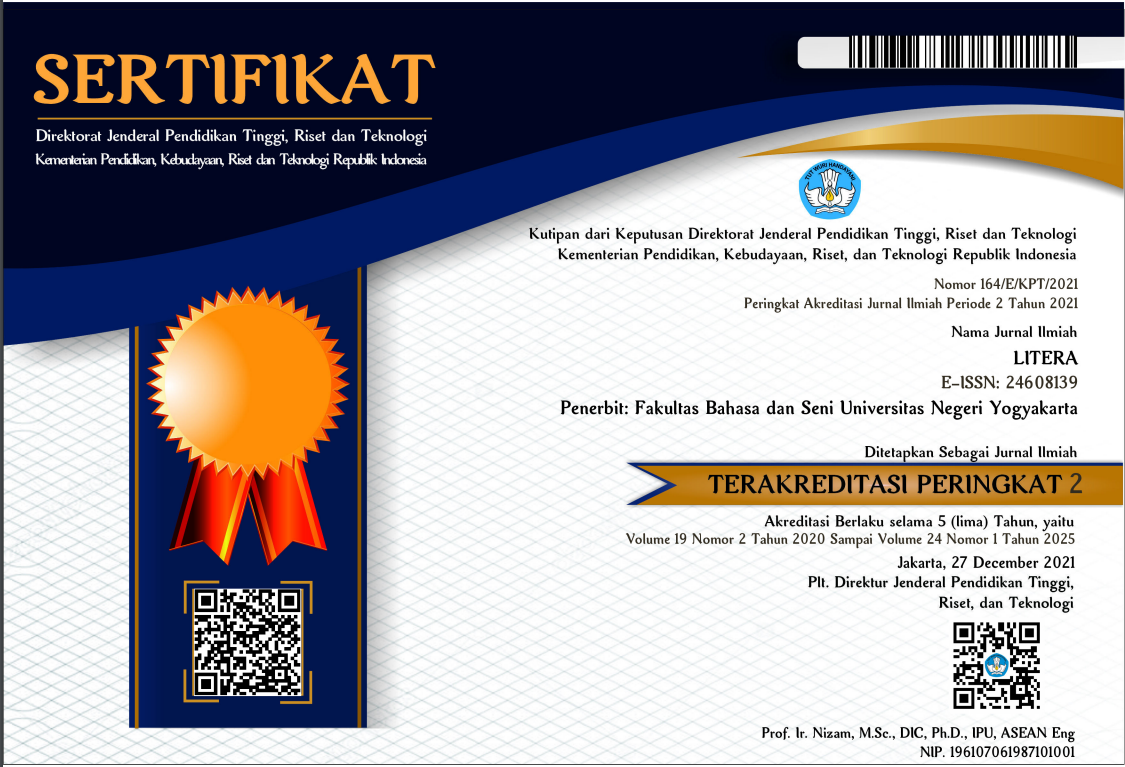CONTRASTIVE ANALYSIS OF PARTICLES IN CHINESE AND INDONESIAN LANGUAGE
Pratomo Widodo, Universitas Negeri Yogyakarta, Indonesia
Abstract
In Chinese and Indonesian, particles are often used and occupying an important place specifically in daily conversation. The study distinguishes ways of using particles in order to propose suggestions that can be useful for Chinese learners in Indonesia. In this article, the author describe the four pairs of particles to compare the similarities and differences in terms of syntax, semantics, pragmatics and analyzing the types and reasons in particle’s using error for Indonesian learners based on corpus HSK. Where the data sources are the examples of a sentence containing particles, the technique of data collection is the technique of reading and taking notes, and the instrument is a human instrument. The authors found that the four pairs of particles have similarities and differences in syntax, semantics and pragmatics: all of them can be used at the end and middle of the sentence, but not all can be used with other particles; all the pairs can translate to one another and can also be translated into other particles or adverbs, but there are some particles sometimes don’t need to be translated; in different contexts, the four pairs of modal particles have different pragmatic functions.
Keywords: particle, Chinese, Indonesian, contrastive analysis
Keywords
Full Text:
PDFReferences
Andriani, F. (2017). Research on mistakes the use of the modal particles “Ba”, “Ma”, “Ne” and Teaching Design for Indonesian Students. Master’s thesis. Faculty of Arts: Jilin University.
Feng, Z. X. (2003). A discourse analysis of mood particle Ba Ne and A in Tionghoa Chinese. Doctoral’s dissertation. Shanghai Normal University.
Hua, X. L. (2002). An analysis of foreign students’ errors of Chinese modal particles. Journal of Zhejiang Normal University (Social Sciences). 27 (5), 89-92. doi:10.3969/j.issn.1001-5035.2002.05.020.
Ji, L. L. (2000). Kamus Lengkap Indonesia Tionghoa. Jakarta: PT Elex Media Komputindo Kelompok Gramedia.
Jian, S. R. (2005). Four Functions of the Toned Words at the End of Sentences. Journal of Nantong University (Social Sciences Edition). 21 (2), 76-80. doi:10.3969/j.issn.1673-2359.2005.02.015.
Jie, S. (2016). On the translation of Chinese ending modal particle “Ne” in Thunderstorm. Journal of Nanjing University of Science and Technology (Social Science Edition). 29 (3), 82-86.
Juan, X. H. (2009). Penelitian syntax dan fungsi pada partikel “Ba” dalam pengajaran bahasa Tionghoa sebagai bahasa asing. Journal of Changchun University of Science and Technology (Higher Education Edition). 4 (5), 56-57.
Kulsum, U. (2012). Membandingkan partikel fatis deh dan dong dalam bahasa Indonesia. Ranah. 1 (1), 40-55. https://doi.org/10.26499/rnh.v1i1.15.
Lan, H. D. (2010). Penelitian kontrastif pada partikel dalam bahasa Tionghoa dan bahasa Thailand. Master’s thesis. Faculty of Arts: Guangxi University of Nationalities.
Liang, H. M. (2017). Tata Bahasa kontrastif dalam Bahasa Tionghoa dan bahasa Indonesia. Guangzhou: Jinan University Press.
Liu, Y. (2010). The primary research of the mood particle in Chinese Courses for Foreigners. Master’s thesis. Hunan University.
Miyake, Y. (2015). Makalah disajikan pada the Second International workshop on Information Structure of Austronesian Languages. Pragmatic particles and information structure in colloquial Indonesian dialogue. Tokyo University of Foreign Studies, Tokyo, Jepang. Hal 102-114. https://core.ac.uk/download/pdf/41886357.pdf.
Ping, S. (2007). Study on the expression word in modern Chinese. Journal of Hetan Teachers College. 27 (5), 74-75. doi:10.3969/j.issn.1671-0908.2007.05.049.
Ping, X. (2007). An error analysis on Chinese modal particles of English-speaking Chinese learners. Master’s thesis. East China Normal University.
Schmitt, N. (2016). An Introduction to Applied Linguistics. ( Xu Jingning, transl.). Beijing: Beijing World Publishing Corporation (Original book, 2002).
Wei, W. X. (2015). On the English translation of modal particles “Ma”, “Ne” and “Ba” in modern Chinese—Taking Teahouse as an example. Master’s thesis. Huaibei Normal University.
Yu, Z. Q. (1993). Tata Bahasa Indonesia Modern. Beijing: FLTRP (Foreign Language Teaching and Research Press).
Zhi, W. (2013). Penelitian kontrastif pada partikel dalam bahasa Tionghoa dan bahasa Laos. Master’s thesis. Faculty of Arts: Guangxi University of Nationalities.
DOI: https://doi.org/10.21831/ltr.v18i3.24223
Refbacks
- There are currently no refbacks.
______________________
__________________________________________________________________________________________________
Litera Journal is published by the Faculty of Languages, Arts, and Culture Universitas Negeri Yogyakarta in collaboration with Himpunan Sarjana Kesusasteraan Indonesia (HISKI)
The International Journal of Linguistic, Literature, and Its Teaching at http://http://journal.uny.ac.id/index.php/litera/ is licensed under a Creative Commons Attribution-ShareAlike 4.0 International License
__________________________________________________________________________________________________















